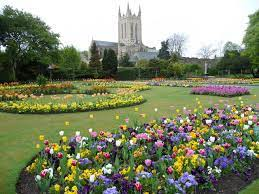By Alasdair English
St. Edmund’s Abbey, in the Abbey Gardens, has been named as one of the best free historic Attractions to visit in the UK by Which? The site, originally owned by St Edmundsbury Borough, but now owned and managed by West Suffolk Council, has ranked among the top seven places to visit that are free in the UK. The Abbey has ranked fifth out of 50 attractions across the UK beating the likes of Bristol Cathedral and Somerset House.

Councillor Ian Shipp, Cabinet Member for Leisure said “it’s delightful news that West Suffolk has one of the country’s top free historic attractions”.
The Abbey ranks among The Houses of Parliament in fourth and Durham Cathedral which leads The way. Which? Rankings described the Abbey as “England’s grandest monastery”. The structure was destroyed by Henry VIII’s men in the 16th Century during the reformation “but two great towers still remain… you can imagine how huge and imposing this place must once have been” continued the Which? Description.
Councillor Shipp said “The Abbey of St Edmund has just celebrated its millennium and it’s ruins in the marvellous Abbey Gardens here in Bury St Edmunds are framed by St Edmundsbury Cathedral. I’m proud that given the cost of living crisis, there are six green flag award winning parks and open spaces for families to enjoy across West Suffolk, and great days out for everyone.”
In 2022, the Abbey celebrated it millennium having been standing for 1000 years. Lots of events were held to commemorate the special occasion including anniversary tours and a pilgrammage day. The Abbey was once one of the most powerful bendictine monasteries in England, the remains, today, include the complete 14th Century Great Gate and Norman Tower. The remains of the Saxon King St. Edmund were moved to the site in 903 and his shrine became a place of pilgrammage. The Abbey itself was founded in 1020 and grew in power until its suppression in 1539 when King Henry VIII closed the Abbey. The King’s men systematically destroyed the vast structure. Apart from the Abbot’s place, the Abbey was allowed to become a quarry for local building stone.
From the English Heritage website, John Leland, speaking in 1539 described the Abbey shortly before it was demolished. Leland captured the vastness of the Abbey in the 16th Century, saying “nor a monastery more noble, whether one considers the endowments, largeness or unparalleled magnificence. One might think even the monastery alone a city.”
Other areas of Suffolk that have been awarded the green flag include Nowton Park, Brandon Country Park, East Town Park, West Stow Country Park and Aspal Close. Councillor Jo Rayner, Deputy Leader of West Suffolk Council, said, on the West Suffolk Council website: “our communities value them as places to be outside, benefit from green exercise and enjoy spending time together.”
The green flag award acknowledges well managed parks and green spaces. Accreditation Manager, Paul Todd, said on the West Suffolk Council Website: “this award is testament to all the hard work of staff and volunteers, who do so much to ensure that it maintains the high standards demanded by the Green Flag Award.”
